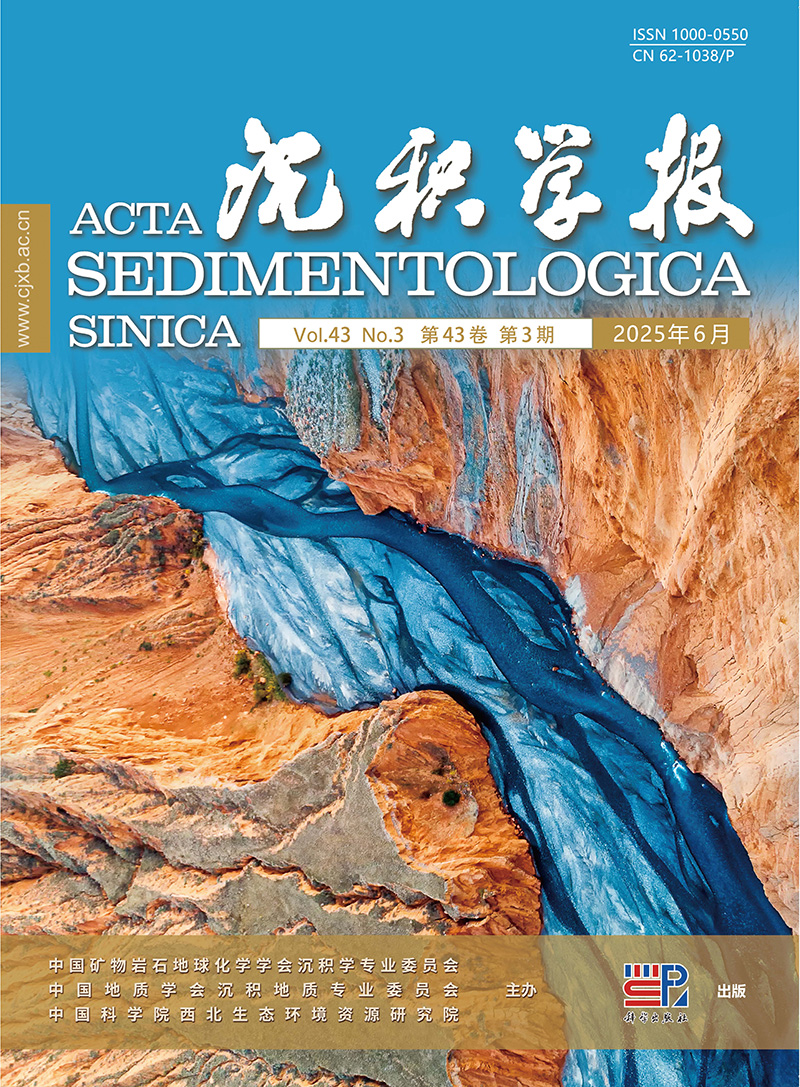HTML
-
中国南方网纹红土是亚热带地区第四纪环境变化研究的良好地质载体,解译网纹红土的形成环境是中国南方红土区古环境研究的重要内容[1⁃2]。网纹红土经历了中等以上强度的化学风化,通常被认为是较湿热气候环境下的风化产物[3⁃5]。在网纹红土中普遍存在网纹化现象,其醒目地质特征是在暖色调的红紫色黏土中镶嵌大量呈斑点、蠕虫、条管等形态的不规则浅色斑纹[5]。伴随着网纹化过程,白色条纹与红色条纹之间出现了一定的物质差异[5⁃9]。已有的研究表明,湿热的气候、土体孔隙、地下水的季节性变化、新构造运动乃至植物根系等可能是网纹发育的重要条件[2,5,9⁃13],网纹化现象可视为物理过程(裂隙及扩张)、生物过程(根系腐烂)、化学过程(如铁质分异)等综合作用的产物[14]。网纹红土很好地记录了中国南方第四纪以来风化特征及其变化趋势,但与网纹红土网纹化现象有关的微观机制仍然有待进一步探究[4,9,13]。目前有关网纹的研究,多将红色条纹与白色条纹视为两个不同的物质单元,对二者进行分离后,再分别测试与分析红色条纹和白色条纹的理化属性以及分异特征。上述研究可从整体上对网纹及网纹化进行认知,但却难以从白色条纹内部变异,以及白色条纹到红色条纹之间过渡变化等微观尺度上认识网纹和网纹化过程。微区分析是对固体样品的一个微小区域直接进行成分分析的技术,具有原位、量微、无损和准确等优点[15⁃16],其为获取元素在土体内部、矿物中的配分和迁移规律提供有力的技术支撑[17⁃18]。微区分析包括电子探针、激光探针(包括激光光谱仪),以及扫描电子显微镜等[19],微区XRF具有良好的穿透性、稳定性及分辨率高等特点,可提供不同尺度、不同层次需求的原位微区分析[16,20]。为此,本文利用微区XRF分析方法对安徽郎溪剖面的网纹红土开展二维微区分析,旨在从微观尺度上进一步认识网纹体内的化学元素含量的空间分布特征,阐述网纹内部可能的化学过程,并为明确网纹的形成机理提供新视角。
-
郎溪剖面(30°58′24″ N,119°7′43″ E)位于安徽省郎溪县十字镇318国道旁,其海拔约40 m,属亚热带季风气候区,年降水量介于1 143~1 503 mm。该网纹红土剖面的质地均一,不含砾且无流水作用痕迹,属于长江中下游地区颇具代表性的加积型红土剖面之一。该剖面自下而上可分为网纹红土、黄棕色土等沉积地层,上覆黄棕色土层的土质疏松,网纹层质地紧实且由上到下白色条纹从密集细小到稀疏宽大,剖面未见底。在该剖面网纹红土层的底部,白色条纹发育情况较为良好,为开展微区分析提供了基础。本文在该剖面的中部和底部用瓶盖(直径约33 mm)采集了两个微区样品(图1)。其中,一个为白色条纹微区样品,另一个则为红色条纹与白色条纹兼具的微区样品(下文简称为红白过渡微区样品)。前者主要用于揭示白色条纹体中元素的空间变异情况,后者用于反映从白色条纹到红色条纹元素含量的空间变化情况。
-
本文采用原位微区XRF分析技术,将采样后的微区样品进行平面处理(粗磨和精磨),使待测样品表面光滑没有空隙,随后将打磨好的样品放入60 ℃的烘箱进行干燥,最后将样品放入微区X射线荧光光谱仪内选择合适位置进行元素分析。为获取微区内地球化学元素含量分布状况,在白色条纹微区样品(19 mm×17 mm)和红白过渡微区样品(12 mm×10 mm)各设置了121个样点(图1),主要测试了SiO2、Al2O3、Fe2O3、K2O、CaO、MgO、Na2O等常量元素,以及Mn、Co、Cu等微量元素。微区地球化学元素测试完成于安徽师范大学资源环境与地理信息工程安徽省工程技术研究中心。元素测试仪器为日本理学公司生产的Rigaku ZSX PrimusⅡ型长色散X射线荧光光谱仪,测试精度为10-6级别,测试含量范围为10-6~100%。测试过程使用中国国家标准土壤样品GSS-3和GSS-6进行监控,并对所得数据运用微型计算机进行程序控制、谱图识别、干扰矫正及数据处理等分析步骤。通过与仪器内国家标准物质信息比对,最终实现对所测样品元素的精确分析,该方法测定结果与电子探针测定结果一致[21],常量元素分析误差优于2%。
对微区网格点测试结果,利用 ArcGIS的地统计方法分析元素地球化学含量的空间分布特征,利用R语言对两个微区样品进行R型因子分析。其中,R型因子分析是研究变量间相互关系的因子分析法,常用于研究元素共生组合,其中每个因子所包含的主要元素,不仅表示元素间的组合关系,而且反映元素间内在的成因联系[22]。本文采用R型因子分析方法的主要目的是对原始数据进行特征提取、信息降维,发掘隐藏在数据下的一组较少的或难以直接观测的变量,并推测其可观测变量变化的主要原因与机制。
1.1. 样品采集
1.2. 研究方法
-
微区测试结果表明(表1,2),无论是白色条纹微区样品,还是白色条纹与红色条纹过渡微区样品的地球化学元素含量均以SiO2、Al2O3和Fe2O3等为主,K2O、CaO、MgO、Na2O、Ti和Mn等元素的含量次之,其总体特征与中国南方网纹红土地区的元素分布特点基本一致,为此本文不再对此进行赘述。为了揭示地球化学元素含量在白色条纹内部变异情况,以及从白色条纹到红色条纹的过渡变化特征,利用统计学方法开展分析(图2,3)。从图2、3可知,在白色条纹体的内部,铁和铁族元素含量的空间分布特征较为相似,皆呈现出从白色条纹中心向外围逐渐增加的趋势,Cu、Zn等元素含量的空间分布特征与之相似,而SiO2、Al2O3、K2O、CaO、MgO、Ti、Rb、Sr等元素含量的空间分布特征则与基本之相反,主要表现为从白色条纹中心向外围呈现逐渐降低的趋势。红白过渡微区样品的铁、铁族元素和Cu、Zn等元素含量的空间分布特征则呈现出从白色条纹向红色条纹逐渐增加的趋势,而SiO2、Al2O3、K2O、CaO、MgO、Ti、Rb、Sr等元素含量的空间分布特征则基本与之相反,表现为逐渐降低的趋势。
样品(数量) SiO2 Al2O3 Fe2O3 MgO CaO Na2O K2O 红白过渡微区样品(n=121) 平均值 53.94 11.00 7.61 0.34 0.37 0.23 1.41 最小值 45.78 9.78 5.77 0.23 0.37 0.21 1.11 最大值 56.47 11.48 13.02 0.37 0.38 0.26 1.51 白色网纹微区样品(n=121) 平均值 51.94 13.31 7.6 0.36 0.48 0.24 1.26 最小值 39.82 10.19 3.43 0.18 0.44 0.21 0.78 最大值 58.36 14.52 16.97 0.45 0.51 0.31 1.48 Table 1. Reticular red clay chemical composition (%) of constant elements
样品(数量) Cu Co Zn Cr Mn Ni Rb Sr Ti Zr 红白过渡微区样品(n=121) 平均值 74.88 41.98 51.20 7 088.04 771.08 860.21 8.66 14.36 6 164.67 360.62 最小值 24 7 49 80 253 29 4 10 4 950 354 最大值 237 140 54 27 617 2 277 3 339 12 17 6 544 371 白色网纹微区样品(n=121) 平均值 138.61 92.09 71.54 16 591.06 0.13 1 815.17 113.64 19.06 6 093.00 317.51 最小值 33 21 66 758 0.01 102 97 11 4 054 310 最大值 386 230 77 48 187 0.37 5 371 121 24 7 190 330 Table 2. Composition of trace element of reticular red clay (×10-6)
-
因子分析方法通过分析众多可观测变量之间的内部依赖关系,揭示原始观测数据中的基本结构,并用少数几个抽象的“潜在”变量(即因子)表示其基本的数据结构[23]。在开展R型因子分析前,首先采用KMO(Kaiser-Meyer-Olkin)和Bartlett法对上述网纹红土微区观测数据进行检验。一般而言,KMO的值越接近于1,说明变量间的相关性越强,越适合因子分析[24]。此次研究的白色条纹微区样品、红白过渡微区样品的KMO分别为0.94和0.95,表明适合进行因子分析。另外,如果变量彼此独立,则无法从中提取公因子,也就无法应用因子分析法。两个微区样品观测数据的Bartlett球形检验的概率皆低于显著性水平0.05,原始观测变量之间的相关性较强,适合进行因子分析。在此基础上,利用R语言展开因子分析,分析结果见表3。
元素 因子1(白红过渡) 因子2(白红过渡) 因子1(白色条纹) 因子2(白色条纹) Cu -0.83 0.56 -0.99 0.11 Co -0.82 0.57 -0.98 0.15 Zn -0.14 0.54 0.08 0.80 Cr -0.82 0.57 -0.99 0.16 Mn -0.82 0.57 -0.99 0.16 Ni -0.83 0.56 -0.99 0.15 Rb 0.64 -0.61 0.82 -0.08 Sr 0.53 -0.59 0.91 -0.11 Ti 0.86 -0.49 0.98 -0.17 Zr 0.57 -0.40 0.44 -0.77 Al2O3 0.99 -0.22 0.98 -0.03 Fe2O3 -0.77 0.64 -0.98 0.19 K2O 0.88 -0.47 0.99 -0.14 Na2O -0.77 0.56 -0.98 0.11 SiO2 0.88 -0.45 0.98 -0.19 CaO 0.60 -0.24 0.97 -0.04 MgO 0.89 -0.41 0.99 -0.13 Table 3. Factor analysis results of the sample data in the micro⁃area
根据累积方差贡献率,对红白过渡微区样品和白色条纹微区样品分别提取了两个主因子。其中,红白过渡微区样品两个主因子的方差贡献率分别为59%和26%,累积方差贡献率达85%,白色条纹微区的两个主因子方差贡献率分别为84%和9%,累积方差贡献率达到93%。累积方差贡献率均达到了80%以上,尤其是白色条纹微区样品因子1的方差贡献率就达到了84%,说明采取两个因子可以很好地体现微区样品地球化学元素含量的空间分异情况。
因子载荷表征了原始观测变量和因子之间的相关程度,可解释和命名因子。根据表3,红白过渡微区因子1的载荷为正且数值较高的地球化学元素主要为Al2O3、K2O、SiO2、MgO等常量元素,以及Ti、Zr等相对稳定元素,而Fe2O3、Mn和Co等铁和铁族元素载荷的数值为负;红白过渡微区观测数据中因子2的各元素因子载荷的正负号基本与因子1相反,表现为Fe2O3、Mn和Co等铁和铁族元素的因子载荷数值为正。白色条纹微区因子1和因子2的各地球化学元素的因子载荷特征与红白过渡微区因子载荷的特征基本一致,但白色条纹微区的因子1的载荷一般明显高于红白过渡微区因子1的载荷,而其因子2的载荷则远低于红白过渡微区的因子2的载荷。
2.1. 微区内元素的分布特征
2.2. 因子分析结果
-
网纹红土的母质沉积期和网纹形成期是先后两个不同时期[6,25⁃26]。加积型网纹红土地层的母质在网纹出现之前是均质的[4],在网纹化过程中,白色条纹和红色条纹发生了物质分异[5⁃9,27⁃28]。其中,铁含量的分异被认为是网纹化的过程的基础,白色条纹中的铁存在明显淋失,导致了红色条纹的全铁含量、游离铁量、无定形铁量,晶质铁量以及络合铁量等一般远高于白色条纹[9]。微区分析结果表明,白色条纹微区样品的全铁含量具有从白色条纹中心向外围逐渐增加的特征,红白过渡微区样品的全铁含量同样呈现出由白色条纹到红色条纹逐渐增加的趋势。以往将白色条纹与红色条纹作为两个物质单位可以看作是对上述特征的简化。因此,开展微区分析有助于补充将红色条纹和白色条纹视为不同物质单元的研究结果,在微观尺度上进一步丰富对网纹化过程的认识。一方面,本文从微区尺度上进一步证实了白色条纹和红色条纹之间确实存在铁的分异;另一方面,研究揭示了白色条纹内部的全铁含量并非是均质的,白色条纹和红色条纹之间全铁含量的差异并非是突变的,而是渐变的。Mn、Co、Ni以及Cu、Cr元素含量的微区分布特征与铁元素微区分布特征较为相似,推测这些元素的分异可能与铁元素具有相似的成因或者与铁元素有关;而K2O、CaO、MgO等常量元素的微区分布特征一般呈现出与铁族元素大体相反的分布趋势,Zr、Ti等相对稳定元素含量的微区分布特征也呈现出由白色条纹到红色条纹逐渐降低的趋势,相异的空间分布趋势可能意味着上述元素含量的空间分异原因与铁以及铁族元素等不同。由于网纹红土的母质是均质的,上述化学元素含量在白色条纹内部,以及由白色条纹到红色条纹的所呈现出的渐变特征较难用脱硅富铝铁化进行解释,网纹化过程是导致微区内元素含量分布的主要原因,这说明在适宜的环境条件下,白色条纹的形成是一个逐渐发育的过程。
通过因子分析可进一步推测可观测变量变化的主要原因与机制。本文两个微区数据的R型因子分析结果的共性特征在于铁以及铁族元素等在因子2具有正载荷,而在因子1的载荷为负,其他元素的载荷则基本与之相反,这说明两个微区样品数据所体现的成因机制较为一致。
一般认为,网纹红土整体形成于温暖湿润的环境,其先后经历了红化以及网纹化等过程,网纹化时期冬夏季气候反差增强且干湿变化加剧[9],干湿交替的季节气候特点有利于中国南方第四纪网纹红土的发育[4]。在上述适宜网纹发育的气候背景下,白色条纹与红色条纹的元素含量的差异主要与二者所处的微观环境差异有关[4⁃6,9,12,14]。前人研究认为,白色条纹主要形成于还原环境,而红色条纹则主要偏氧化环境,微观环境的差异则导致了白色条纹化学风化淋溶程度往往要高于红色条纹[29⁃31]。在表生地球化学条件下,铁元素一般主要以难溶的三价铁矿物形式残留在风化物中,在还原环境中较为稳定的三价铁矿物可被还原为二价铁从白色条纹中迁出[9],流出土体进入地下水或者在土层内部迁移[8,13,32],红色条纹则可能为白色条纹淋溶出的二价铁的淀积区[8⁃9,13,32]。在适宜的气候背景下,上述铁的淋溶和淀积过程又形成了正反馈机制[4],极大地促进了网纹产生并逐渐发育,这是白色条纹内部、红白过渡微区铁元素出现空间分异的主要原因。另外,铁族元素如Mn、Co等与铁具有相近的存在形式,以及迁移、沉淀的物理化学条件,因此可推测其与铁元素分异形成机制相似。
加积型网纹红土地层的母质在网纹出现之前是相对均质的[4]。自然界中Zr、Ti、Al等是化学性质相对稳定的元素[33⁃34],这些元素在白色条纹中的含量相对较高,而在红色条纹中的含量相对略低,表明其主要与 Fe、Mn 等元素淋溶和淀积有关,即随着铁和铁族元素等在白色条纹中淋溶迁移,以及在红色条纹中的沉淀积累,Ti、Zr等元素在白色条纹中滞留并相对富集,而在红色条纹中则被稀释而表现出相对亏损[4,6,8⁃9]。对于在因子1上具有较高正载荷的K、Ca、Mg等易溶的常量元素而言,一方面因其赋存矿物抗风化性质的差异,使得淋溶迁移程度存在差异,如K常赋存于抗风化强度强的正长石,Ca和Mg主要赋存于碳酸盐矿物及斜长石中,斜长石是最易遭受化学风化的矿物之一[14,35];另一方面白色条纹中的铁元素淋溶迁移导致了易溶元素的相对富集,红色条纹中则因铁和铁族元素的富集而相对亏损,其与相对稳定元素含量的空间分异成因基本相似。
上述是微区内元素含量空间分异的主要原因,但白色条纹与红色条纹元素地球化学特征的差异不仅是铁的淋溶富集及其导致的其他元素含量的相对增减,微环境的改变也会引起元素自身行为的变化[6]。因子分析结果表明,Na与其他易溶元素的因子载荷符号以及含量的分布特征相异。Na赋存于长石(主要是斜长石)、云母等矿物中,受风化作用易发生迁移淋溶,由于白色条纹的淋溶程度高于红色条纹且两者为同源物质[29⁃31],该元素的含量可能既受该组分自身的变化,又受铁和铁族元素淋溶或沉淀等导致的相对富集和亏损共同影响,这两个因素的耦合导致了该组分含量的变化与其他易溶组分含量变化存在一定差异。相关研究也发现红色条纹中钠含量高于白色条纹[36],与本研究结果相似,但具体过程有待进一步探究;至于白色条纹中的铜、锌元素,受氧化还原条件影响相对较弱,其淋滤迁移可能主要与铁锰氧化物对其吸附和解吸作用有关[37⁃38],受铁族元素的影响但与铁和铁族等元素分异原因可能不同;Cr元素在氧化还原条件变化时,其化学行为异于铁、锰等元素,可能另有其他机制如络合迁移[39⁃41]。
综合以上分析,红白过渡微区的因子1主要体现了白色条纹中铁和铁族元素等的淋溶迁移,K、Ca、Mg等易溶常量元素以及Ti、Zr等稳定元素的相对富集过程;红白过渡微区的因子2则主要体现为红色条纹中铁和铁族元素的淀积过程。白色条纹微区与红白过渡微区因子分析结果相似,但由于白色条纹微区因子1的方差贡献率达84%,说明在白色条纹内部主要存在铁和铁族元素淋溶迁移,以及K、Ca、Mg等易溶常量元素和Ti、Zr等稳定元素的相对富集过程;对于因子2所表征的铁的淀积过程,有研究指出在白色条纹发育区铁也并非是单向淋出的,也存在铁沉淀[42],但由于因子2的差贡献率仅为9%,远低于因子1且因子2中各元素的因子载荷也相对较小,说明在白色条纹区铁沉淀即使存在也相对较弱。
-
(1) 白色条纹内部并非是均质的,其元素含量的空间分布具有从条纹中心到外围的渐变特征。其中,铁和铁族元素的含量主要呈现出从白色条纹中心到外围增加的趋势,而其他常量元素以及Ti、Zr等稳定性元素含量的空间分布趋势则与之相异;红白过渡微区样品结果表明,由白色条纹到红色条纹元素含量的空间变化也呈现渐变特征。鉴于红色条纹与白色条纹物源一致,元素含量的空间分布特征说明网纹化是一个持续发育的过程。
(2) 因子分析揭示了网纹形成的元素分异的主要过程。无论是白色条纹微区还是红白过渡微区,其共性特征皆以因子1为主,主要指示了铁在白色条纹中的淋溶迁移,以及易溶常量元素和稳定元素的相对富集过程;而因子2中铁族元素及Cu、Zn等具有较高正载荷,反映了铁和铁族元素等的淀积过程,以及铁锰氧化物对Cu、Zn等的吸附过程等。










 DownLoad:
DownLoad:

